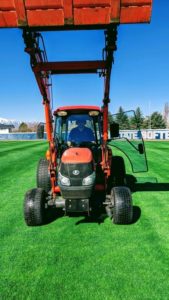Typically, when everyone’s calendars turn to August, grounds crews at universities and colleges are putting final touches on the campus acreage while preparing for students’ returning from summer vacation. Sports field managers at this segment traditionally have seasonal staff in place, and all playing surfaces are in prime condition for fall sports training camps. But like many other industries, this August is different.
Shane Richards is the Landscape Operations and Maintenance Manager at Utah State University and represents one of the many small to mid-sized institutions in the United States which carries a facility maintenance staff in charge of everything from landscaping around academic buildings to the practice football field. Although his team is smaller than normal with a lack of seasonal staff, the absence of mid-summer activities held by Utah State fall sports teams, Richards’ sports fields have benefited from the lack of play, and the ability for he and his team to work on projects that have been pushed down the priority list in years past.
“Without lineman pushing sleds on the field, or any of the other sports practicing, we’ve actually been able to keep  them game ready,” Richards said. “We’ve been able to water it whenever we want, while enhancing the fertilizing and mowing programs, so our cost to maintain the fields has gone down, and the quality has gone up because it has been closed.”
them game ready,” Richards said. “We’ve been able to water it whenever we want, while enhancing the fertilizing and mowing programs, so our cost to maintain the fields has gone down, and the quality has gone up because it has been closed.”
In regard to safety, to keep the campus clear of COVID-19, Utah State’s operations group is responsible for all custodial work, but within Richards’ responsibilities there are defined guidelines. Social distancing is a must in all situations, and if the crew is mowing grass, it requires personal protective equipment such as ear plugs and safety glasses. Additionally, Utah State now has two employees on staff for the rest of the calendar year solely responsible for disinfecting equipment.
Additionally, versatility has been critical during the pandemic, especially for universities of Utah State’s size, as they will need to juggle multiple projects now more than ever. Due to the fact Richards has less seasonal staff, usually consisting of high school and college students, he noted he will utilize his sports field managers in other places on campus when the fields are in good condition and require less attention.
Since the beginning of the pandemic, the Sports Turf Managers Association has been putting together Town Hall conversations with each sector of the industry, including colleges and universities. When this group of sports field managers gathered virtually, they discussed how they maintained the quality of their fields despite cutbacks, what projects they were moving up in their calendars and more.
View the full Town Hall discussion between sports field managers at colleges and universities.
Tips for Sports Field Managers from Shane Richards
Other Sports Field Management Resources
Route to Recovery – Healing Through Sports Part I
Route to Recovery – Healing Through Sports Part II
Where Do I Start to Maintain My Athletic Fields Again?
An Ever-Evolving Roller Coaster for Parks and Recreation Sports Field Managers
Despite Canceled Season, Sports Field Managers in Minor League Baseball are Plenty Busy
Looking to share what you’ve experienced thus far as a sports field manager in the pandemic? Contact Nate Rubinstein at nrubinstein@buffalo.agency.